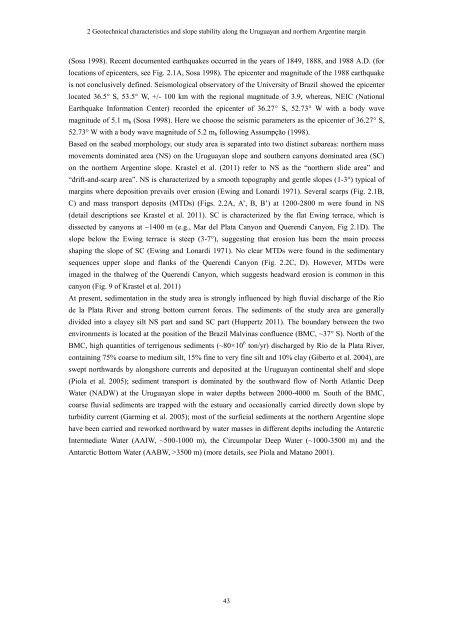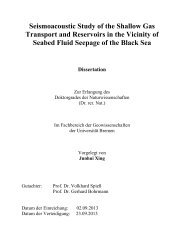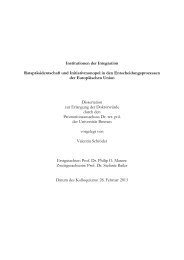Slope stability along active and passive continental margins ... - E-LIB
Slope stability along active and passive continental margins ... - E-LIB
Slope stability along active and passive continental margins ... - E-LIB
Create successful ePaper yourself
Turn your PDF publications into a flip-book with our unique Google optimized e-Paper software.
2 Geotechnical characteristics <strong>and</strong> slope <strong>stability</strong> <strong>along</strong> the Uruguayan <strong>and</strong> northern Argentine margin<br />
(Sosa 1998). Recent documented earthquakes occurred in the years of 1849, 1888, <strong>and</strong> 1988 A.D. (for<br />
locations of epicenters, see Fig. 2.1A, Sosa 1998). The epicenter <strong>and</strong> magnitude of the 1988 earthquake<br />
is not conclusively defined. Seismological observatory of the University of Brazil showed the epicenter<br />
located 36.5°S, 53.5°W, +/- 100 km with the regional magnitude of 3.9, whereas, NEIC (National<br />
Earthquake Information Center) recorded the epicenter of 36.27°S, 52.73°W with a body wave<br />
magnitude of 5.1 m b (Sosa 1998). Here we choose the seismic parameters as the epicenter of 36.27°S,<br />
52.73°W with a body wave magnitude of 5.2 m b following Assumpção (1998).<br />
Based on the seabed morphology, our study area is separated into two distinct subareas: northern mass<br />
movements dominated area (NS) on the Uruguayan slope <strong>and</strong> southern canyons dominated area (SC)<br />
on the northern Argentine slope. Krastel et al. (2011) refer to NS as the “northern slide area” <strong>and</strong><br />
“drift-<strong>and</strong>-scarp area”. NS is characterized by a smooth topography <strong>and</strong> gentle slopes (1-3°) typical of<br />
<strong>margins</strong> where deposition prevails over erosion (Ewing <strong>and</strong> Lonardi 1971). Several scarps (Fig. 2.1B,<br />
C) <strong>and</strong> mass transport deposits (MTDs) (Figs. 2.2A, A’, B, B’) at 1200-2800 m were found in NS<br />
(detail descriptions see Krastel et al. 2011). SC is characterized by the flat Ewing terrace, which is<br />
dissected by canyons at ~1400 m (e.g., Mar del Plata Canyon <strong>and</strong> Querendi Canyon, Fig 2.1D). The<br />
slope below the Ewing terrace is steep (3-7°), suggesting that erosion has been the main process<br />
shaping the slope of SC (Ewing <strong>and</strong> Lonardi 1971). No clear MTDs were found in the sedimentary<br />
sequences upper slope <strong>and</strong> flanks of the Querendi Canyon (Fig. 2.2C, D). However, MTDs were<br />
imaged in the thalweg of the Querendi Canyon, which suggests headward erosion is common in this<br />
canyon (Fig. 9 of Krastel et al. 2011)<br />
At present, sedimentation in the study area is strongly influenced by high fluvial discharge of the Rio<br />
de la Plata River <strong>and</strong> strong bottom current forces. The sediments of the study area are generally<br />
divided into a clayey silt NS part <strong>and</strong> s<strong>and</strong> SC part (Huppertz 2011). The boundary between the two<br />
environments is located at the position of the Brazil Malvinas confluence (BMC, ~37°S). North of the<br />
BMC, high quantities of terrigenous sediments (~80×10 6 ton/yr) discharged by Rio de la Plata River,<br />
containing 75% coarse to medium silt, 15% fine to very fine silt <strong>and</strong> 10% clay (Giberto et al. 2004), are<br />
swept northwards by <strong>along</strong>shore currents <strong>and</strong> deposited at the Uruguayan <strong>continental</strong> shelf <strong>and</strong> slope<br />
(Piola et al. 2005); sediment transport is dominated by the southward flow of North Atlantic Deep<br />
Water (NADW) at the Uruguayan slope in water depths between 2000-4000 m. South of the BMC,<br />
coarse fluvial sediments are trapped with the estuary <strong>and</strong> occasionally carried directly down slope by<br />
turbidity current (Garming et al. 2005); most of the surficial sediments at the northern Argentine slope<br />
have been carried <strong>and</strong> reworked northward by water masses in different depths including the Antarctic<br />
Intermediate Water (AAIW, ~500-1000 m), the Circumpolar Deep Water (~1000-3500 m) <strong>and</strong> the<br />
Antarctic Bottom Water (AABW, >3500 m) (more details, see Piola <strong>and</strong> Matano 2001).<br />
43
















